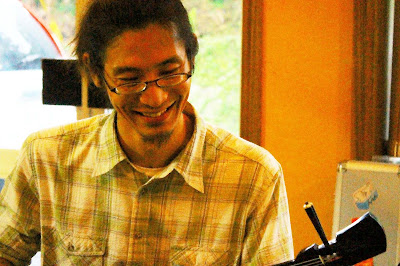Occupied Okinawa #13: Sanshin Music
As I already mentioned in an earlier post on the second to the last day of my trip to Okinawa our hosts held a small party in our honor. The meeting was held in a cafe which will soon be open owned by Midori Teruya. Midori was kind enough to escort Ed Alvarez and myself around Naha and Ginowan on our last day in Okinawa, and took us to several locations including a mall for some last minute shopping, an independent movie theater to watch the film Standing Army, and the Sakima Art Museum.
Over our ten days in Okinawa we spent alot of time at Midori's Cafe and the Okinawan language school on the floor above. The school is free for the public and is just getting started. I took some pictures, video and notes while I sat through one of their sessions and will hopefully we writing about it later. As the Chamorro and Okinawan language are in similar not too healthy states, that was something that I had constantly discussed with people.
While we were sitting at the cafe sampling some Okinawan treats I have to admit I was very jealous. Midori intends that when the cafe is open it not just be any cafe, but be a place for activists who are interested in demilitarization, decolonization and language revitalization. In other words, it is a place from which her and her friends can spend time together relaxing or making plans for their activities and organizations. I am jealous because there is no such place on Guam. I still remember when I first moved back to Guam in 2008 after being away for four years in grad school. Several members of the group Famoksaiyan had also moved back and so we were determined to be active. The issue of where to meet however became a problem. When we met in homes people tended to be very laid back and there was no public place that was obviously ideal for meeting to discuss decolonization. We tried coffee shops and even once met at Wendy''s in Barrigada. It was a very eye-opening experience for me, to think about how the movement has gotten quite far despite alot of public infrastructure. No activist groups have offices or paid positions and few have any websites and so to think that we have even changed the conversation a little despite these disadvantages is immense.
The decolonization movement on Guam in its current form still has yet to really take shape. It was weakened as groups like Nasion Chamoru and OPIR started to fade, but it was invigorated by the military buildup. Where it goes from here will depend on whether it can achieve a certain type of public presence or whether it will remain the extra projects of conscious people, who are committed to the cause and thus continue to pile more onto their already overloaded plates.
My favorite part of the party at Midori's cafe was that we were treated to some sanshin music by Jun Sakima, whose father is the owner of the Sakima Art Museum. The sanshin is a three-string guitar that was introduced to Okinawa via China and later made its way to Japan. He played several songs song of which got the Okinawans in attendance up and dancing. I wish I could remember the names of the songs that the played and what they were about. According to what I remember one song was about refusing to accept the world around you as real but always feeling that it is a dream. Another, the one that had everyone dancing, was a song that celebrated the end of the World War II.
I've posted below some videos of Jun playing.






Comments